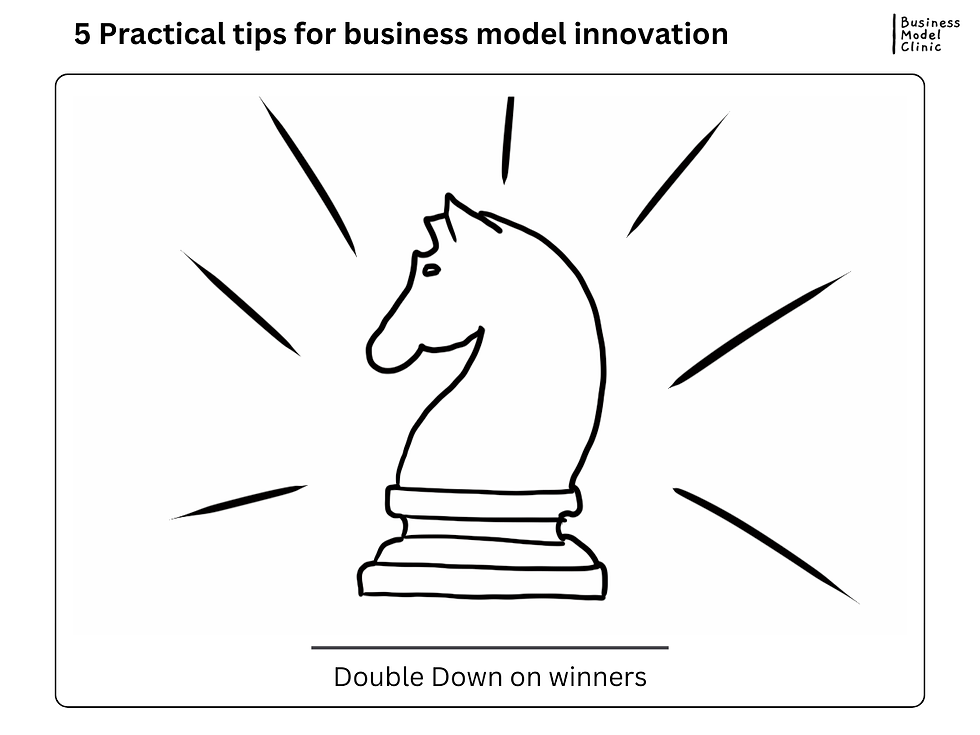5 Practical tips for business model innovation
- Baran Korkut
- Jan 27
- 4 min read
Updated: Mar 18
Business model innovation is about more than creating new products or services. It’s about rethinking how your business creates, delivers, and captures value—and it doesn’t need to be overly complicated. In fact, any change to an existing business model that introduces a new, profitable design can qualify as innovation. The key is to ensure that this change reverberates across interconnected areas of your business model, creating a butterfly effect of improvements. If it doesn’t, something crucial may have been overlooked.
Some of the most successful companies we know today didn’t just innovate their products—they fundamentally changed their business models. Netflix, for instance, transformed the way people consumed entertainment, shifting from DVD rentals to a streaming platform powered by subscription revenue and user data. Airbnb turned hospitality upside down by connecting hosts and travelers in a seamless two-sided marketplace. These innovations weren’t random strokes of genius; they were deliberate attempts to solve unmet needs, leverage strengths, and capitalize on emerging opportunities.
But what about your business model? Whether you’re adapting an existing model or searching for entirely new approaches, the journey starts by asking the right questions.
Double down on your strengths
Every company has something others can’t easily replicate, whether it’s patented technology, an efficient cost structure, or a loyal customer base. Dyson, for instance, capitalized on its patented cyclone vacuum technology to expand into haircare and air purifiers, leveraging its engineering expertise in new markets. Similarly, Amazon’s deep investments in data capabilities helped streamline its retail operations, and when the company realized the value of this infrastructure, it launched AWS—a completely different business model that became a major profit driver. The lesson here is simple: figure out what your company does better than anyone else and explore ways to amplify it.

Look deep into customers and markets
Your current customers likely have adjacent problems that your business is perfectly positioned to solve. Take Amazon Prime, which started as a faster shipping solution and evolved into a bundle of services that included streaming, exclusive deals, and more. By addressing multiple customer needs, Amazon deepened its relationships and boosted loyalty. At the same time, don’t overlook non-customers—those who might desperately need your solution but aren’t being served yet. Square did this by targeting small businesses and individuals who had been ignored by traditional banking systems, opening up entirely new segments for its payment solutions.

Use technology where it matters
Technology isn’t just a tool—it can fundamentally transform your business model, unlocking exponential revenue growth or drastic cost reductions. To spark creativity, ask yourself this bold question: If I had unlimited access to technology, how could I grow revenue tenfold or reduce costs by the same magnitude?
Consider LEGO’s transformation. Faced with declining sales, the company embraced digital innovation by launching video games, apps, and an online platform where users could design custom LEGO sets. This pivot not only revitalized the brand but also expanded its audience in ways that traditional strategies couldn’t achieve. The reality is, if you can imagine a solution, you can likely find a partner, vendor, or collaborator who can bring it to life.

Copy from startups
Steve Jobs once said "Good artists copy, great artists steal." In fact he stole the quote from Pablo Picasso.
Startups thrive by reimagining business models and challenging incumbents. Beyond Meat, for example, identified a growing demand for plant-based foods and created a value proposition that meat producers couldn’t initially match. Established players like Tyson Foods eventually adopted similar strategies, but Beyond Meat’s innovation set the standard.
Stripe is another example, disrupting the payments space by streamlining online payment processing. Established financial institutions like Adyen recognized this shift and began offering similar services. By studying startups in your industry, you can identify opportunities to adapt and scale their ideas with your existing resources.

Get Inspired
While the above are great practices to kickstart business model innovation, sometimes you may need inspiration to come up with ideas. Here are some sources for inspiration:
Freshwatching
Don't benchmark, look beyond your industry to identify unconventional approaches that could disrupt the norms in yours. For example, could you take cues from subscription services in SaaS, platform ecosystems, or shared economy models? Ask yourself: What taboo in your industry could you break?
X-as-a-Service
Transform your offerings into ongoing services instead of one-time sales. Whether it’s software, physical products, or outcomes, the “as-a-service” model generates recurring revenue and strengthens customer relationships.
Building a Platform
Platforms bring together two or more groups—like buyers and sellers—creating value through their interactions. They allow you to scale exponentially by facilitating collaboration rather than creating everything yourself.
Use real trends
Trends like AI, sustainability, remote work, and decentralized networks are reshaping industries. These trends often indicate shifts in customer needs or industry standards. Could AI improve your Key Activities or Cost Structure? Could sustainability initiatives attract new Customer Segments? Emerging trends provide fertile ground for innovative thinking.

Business model innovation starts with ideas, but ideas alone won’t transform your business. They’re merely starting points—blueprints of possibility. What truly matters is how you bring those ideas to life through testing and experimentation.
Every innovation comes with uncertainties: Will customers see value in your new offering? Can your cost structure support scaling? Does your Value Proposition resonate with an untapped segment? These are questions that can only be answered through real-world feedback.
By running small, focused experiments, you can validate your assumptions and refine your ideas based on actual results. Testing allows you to uncover what works, what doesn’t, and where to pivot. In the end, it’s not the original idea but the data-driven adjustments you make that define your success.
So, take that bold first step, but let your tests and learnings guide you to the business model that’s built to last.




Comments